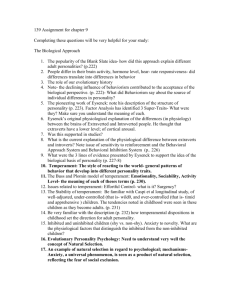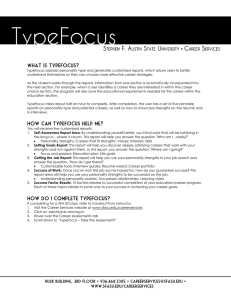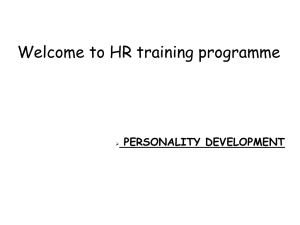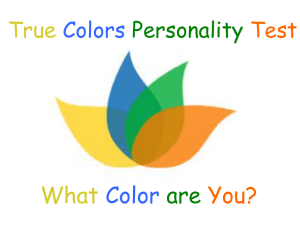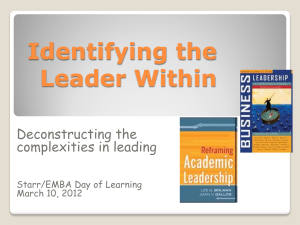TypeFocus 2014
advertisement
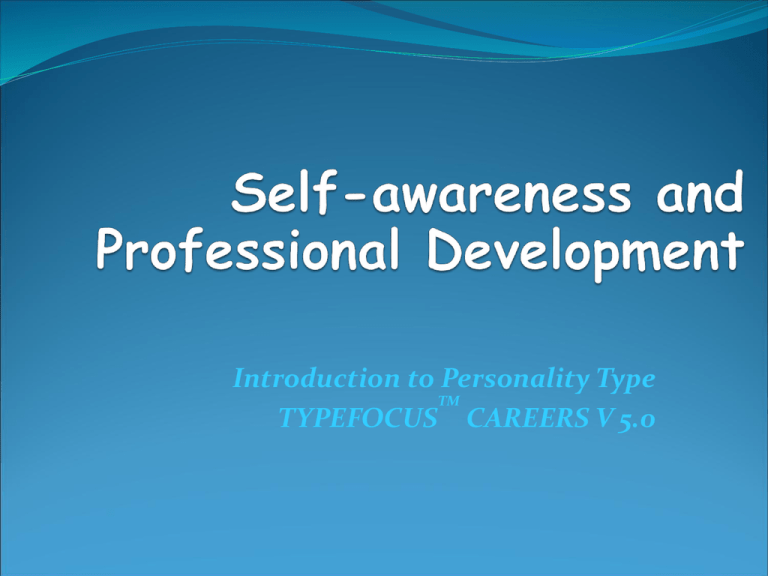
Introduction to Personality Type TM TYPEFOCUS CAREERS V 5.0 What will you learn today? Overview of Personality Type Theory Four type-factor preferences Affirm your own personality type Application of Theory Understanding yourself better when: • career planning Understanding others better when: • communicating one-on-one • communicating in a team 1 Understanding Others Through Understanding Yourself Carl Jung 1875 - 1961 2 It all starts with self-awareness • • • • Your strengths & talents What affects your job satisfaction Identify areas of growth Increases self-acceptance Helps you understand others: • Better communications • Improved teamwork • Less conflict 3 Why do self assessment? 4 Energy Understanding Others Through Understanding Yourself EXTRAVERSION Being energized through contact with other people or through engaging in activities(the outer world) INTROVERSION Being energized through ideas, quiet times, or solitude (the inner world) 5 Information Understanding Others Through Understanding Yourself SENSING Paying attention to what you perceive through the five senses: seeing, hearing, touching, smelling, and tasting INTUITION Paying attention to what might be described as the sixth sense—the unseen world of meanings, inferences, hunches, insights, and connections 6 Understanding Others Through Understanding Yourself Decisions THINKING FEELING Making decisions based on impartial criteria— cause-effect reasoning, constant principles or truths, and logic Making decisions based on values-based, person-centered criteria, seeking harmony 7 Understanding Others Through Understanding Yourself Approach to Life JUDGING Want to live an ordered life, with goals and structure, making decisions so you can move on PERCEIVING Want to live a spontaneous life with flexibility, staying open to new information and possibilities 8 Understanding Others Through Understanding Yourself Function Pairs 9 Understanding Others Through Understanding Yourself Reframing Feeling Lens What a feeling person perceives: Logic Compassion Decisions based on Policy and procedures Taking people’s feelings into account Mercy 10 Understanding Others Through Understanding Yourself Reframing Feeling Lens What a feeling person perceives: The person does NOT see the COMPLEMENTARY STRENGTH - only the lack of feeling - therefore the perception is a NEGATIVE one - that is: UN-feeling. Logic Business-like decisions Decisions based on Policy and procedures Decisions based on organizational needs Justice 11 Understanding Others Through Understanding Yourself TypeFlexing Working to the OTHER PERSON’S strengths For Extraverts - action, talking, group work For Introverts - prefer written communication, one-on-ones For Sensing-types - practical applications, specific examples For iNtuition-types - consider future possibilities, broad issues For Thinking-types - want logic and business-like approach For Feeling-types - prefer to be compassionate and harmonious For Judging-types - want schedules and deadlines For Perceiving-types - resist too much organization, open to change. 12 Understanding Others Through Understanding Yourself Organizational Culture 13 Understanding Others Through Understanding Yourself The End 14


